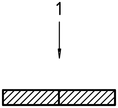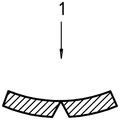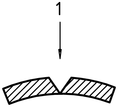ISO 6603-1-2000 “Kunststoffen – Bepaling van het lek-impactgedrag van harde kunststoffen – Deel 1: Niet-instrumentele impacttests”
invoering
ISO (Internationale Organisatie voor Standaardisatie) is een mondiale alliantie van nationale normalisatie-instellingen (ISO-lidorganisaties). De ontwikkeling van internationale normen wordt doorgaans uitgevoerd via technische ISO-commissies. Elke aangesloten instelling die geïnteresseerd is in een onderwerp waarover een technische commissie is opgericht, heeft het recht om in die commissie vertegenwoordigd te zijn. Internationale gouvernementele en niet-gouvernementele organisaties die samenwerken met ISO zijn ook bij dit werk betrokken. ISO werkt nauw samen met de Internationale Elektrotechnische Commissie (IEC) over alle kwesties van elektrische standaardisatie.
Internationale normen worden opgesteld in overeenstemming met de regels gegeven in Deel 3 van de ISO/IEC-richtlijn.
Het ontwerp van de internationale norm dat door de Technische Commissie is aangenomen, zal ter stemming onder de aangesloten organen worden verspreid. Publicatie als internationale standaard vereist goedkeuring van ten minste 75% van aangesloten instellingen.
Please note that some elements of this part of ISO 6603 Kan het voorwerp uitmaken van een octrooirecht. ISO is niet verantwoordelijk voor het identificeren van dergelijke patenten.
De internationale standaard ISO 6603-1 was developed by the Technical Committee ISO/TC61, Kunststoffen, Subcommissie SC 2, Mechanische eigenschappen.
ISO 6603-1-2000 “Kunststoffen – Bepaling van het lek-impactgedrag van harde kunststoffen – Deel 1: Niet-instrumentele impacttests”
De tweede editie annuleert en vervangt de technisch herziene eerste editie (ISO 6603-1:1985).
ISO 6603 bestaat uit de volgende onderdelen, under the general heading Plastics – Bepaling van het lek-impactgedrag van harde kunststoffen:
– Deel 1: Niet-instrumentele impacttests
– Deel 2: Instrumented impact testing
Appendix A of this part of ISO 6603 is for information purposes only.
1 Bereik
This standard specifies a method for determining, under specified conditions, the puncture impact properties of rigid plastics in the form of flat specimens, such as disks or squares. The sample can be molded directly, cut from the sheet or removed from the finished product. Different types of samples and test conditions are defined.
ISO 6603-1-2000 “Kunststoffen – Bepaling van het lek-impactgedrag van harde kunststoffen – Deel 1: Niet-instrumentele impacttests”
These drop dart methods are used to study the behavior of plastic films or molds under the impact of a firing pin perpendicular to the specimen plane.
Dit deel van ISO 6603 can be used if it is sufficient to characterize the impact behavior of plastics by an impact failure energy threshold based on many samples. If a force-deflection or force-time plot recorded at a nominal constant firing pin speed is necessary to characterize impact behavior in detail, ISO 6603-2 is gebruikt.
These test methods are suitable for specimens with thicknesses between 1 mm and 4 mm.
Note For thicknesses less than 1 mm, ISO 7765 is recommended. If the equipment is suitable, it is possible to test thicknesses greater than 4 mm, but this test falls outside the scope of ISO 6603-1 en ISO 6603-2.
These methods are suitable for the following types of materials:
Rigid thermoplastic molding and extrusion materials, including filled, unfilled and reinforced compounds and sheets;
– Rigid thermosetting molding and extrusion materials, inclusief vul- en versterkingsmiddelen, sheets and laminates;
ISO 6603-1-2000 “Kunststoffen – Bepaling van het lek-impactgedrag van harde kunststoffen – Deel 1: Niet-instrumentele impacttests”
Fiber-reinforced thermoset and thermoplastic composites, including unidirectional or non-unidirectional reinforcement materials, such as MATS, geweven stof, woven roving, cut strands, combined and mixed reinforcement materials, roving, milled fibers and sheets made from pre-impregnated materials (prepregs).
These methods are also applicable to samples molded or machined from finished products, laminates and extruded or cast plates.
The test results are comparable only when the preparation conditions, size and surface of the sample and the test conditions are the same. In het bijzonder, the results determined on specimens of different thicknesses cannot be compared with each other (see Appendix E: – to ISO 6603-2). A comprehensive assessment of the impact stress response requires measurement of the impact velocity and temperature of different material variables, such as crystallinity and moisture content.
The impact behavior of the finished product cannot be predicted directly from this test, but samples can be taken from the finished product (see above) for testing by these methods.
Test data developed through these methods should not be used in design calculations. Echter, information on the typical behaviour of the material can be obtained by testing at different temperatures and impact velocities (see Annex D of ISO 6603-2: -), varying thickness (see Annex E of ISO 6603-2: -) and testing samples prepared under different conditions.
Dit deel van ISO 6603 describes two statistical test methods:
– Methode A: Staircase Method (Individual) (preferred)
In this method, a uniform energy increment is used during the test. After testing each sample, the energy is reduced or increased by uniform increments, depending on the observations (pass or fail) of the previous test.
ISO 6603-1-2000 “Kunststoffen – Bepaling van het lek-impactgedrag van harde kunststoffen – Deel 1: Niet-instrumentele impacttests”
– Methode B: Group method (Optioneel)
In this method, a continuous group of at least ten samples is tested. The impact failure energy is calculated statistically.
2 Normatieve verwijzingen
De volgende normatieve documenten bevatten bepalingen die:, door verwijzing hierin, vormen de bepalingen van dit deel van ISO 6603. Voor gedateerde referenties, eventuele latere herzieningen of wijzigingen van deze publicaties zijn niet van toepassing. Echter, Parties to agreements based on this part of ISO 6603 worden aangemoedigd om de mogelijkheid te onderzoeken om nieuwe versies van de volgende normatieve documenten toe te passen. Voor ongedateerde referenties, van toepassing is een nieuwe versie van het bedoelde normstellingsdocument. ISO- en IEC-leden houden een register bij van momenteel geldige internationale normen.
ISO 291:1997, Kunststoffen. Adjust and test the standard atmosphere.
ISO 293:1986, Kunststoffen. Compression forming sample of thermoplastic material.
ISO 294-3:1996, Kunststoffen. Spuitgieten van thermoplastische materiaalmonsters. Deel 3: Small board.
ISO 295:1991, Kunststoffen. Compression molding of thermosetting material samples.
ISO 1268:19741), Kunststoffen – Preparation of glass fiber reinforced, resin bonded, low pressure laminates or panels for test purposes.
ISO 2818:1994, Kunststoffen. The sample was prepared by machining.
ISO 7765-1:1988, plastic films and sheets. The impact resistance was determined by the free falling dart method. Deel 1: Staircase method.
ISO 7765-2:1994, plastic films and sheets. The impact resistance was determined by the free fall dart method. Deel 2: Instrumental puncture test.
ISO 6603-1-2000 “Kunststoffen – Bepaling van het lek-impactgedrag van harde kunststoffen – Deel 1: Niet-instrumentele impacttests”
3 termen en definities
Voor de doeleinden van dit deel van ISO 6603, de volgende termen en definities zijn van toepassing:
3.1 Overzicht
3.1.1 Failure
Any visible breakage of the specimen surface
3.2 Failure standard terms
3.2.1 Crack
Any cracks that are visible to the naked eye and cannot penetrate the entire thickness of the material
See: Figuur 1
3.2.2 Broken
Any cracks throughout the entire thickness of the material
See: Figuur 2
3.2.3 Penetration
Failure of the firing pin to penetrate the entire thickness of the specimen
See: Figuur 3 B)
3.2.4 Grinding
Break the sample into two or more pieces
See: Figuur 3 A)
3.3 Impact failure items
3.3.150 % impact failure energy E50
The energy that causes 50% of the sample to fail, as defined in 3.1.1
3.3.250 % impact failure mass M50
The mass that causes 50% of the sample to fail at a given fall height, as defined in 3.1.1
3.3.350 % impact failure mass H50
50% impact failure height H50 uses the height at which a given falling mass causes 50% sample failure, as defined in 3.1.1
Figuur 1 – Specimen sections damaged by “cracks” [B) and c) after bending by hand
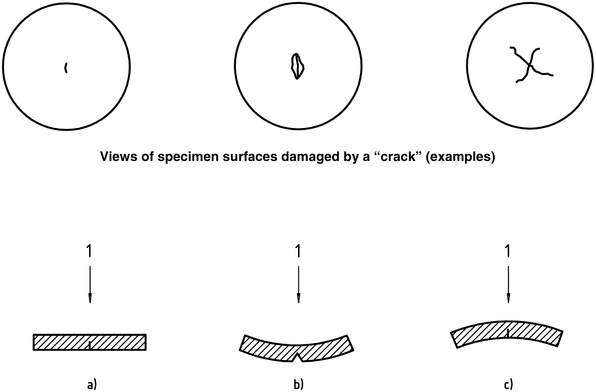
| 1 | Impact direction |
ISO 6603-1-2000 “Kunststoffen – Bepaling van het lek-impactgedrag van harde kunststoffen – Deel 1: Niet-instrumentele impacttests”
Figuur 2 – Slices passed through the specimen are damaged by “breakage” [B) and c) after bending by hand
| A)
| B)
| C)
|
| 1 | Impact Direction |
Figuur 3 – Examples of “broken” failures [A) En “penetrated” [B)
A)
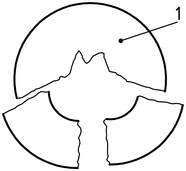
B)
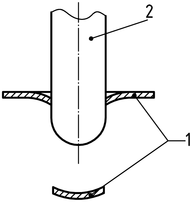
| 1 | Voorbeeld |
| 2 | Darts with hemispherical heads |
Alleen het standaardinformatiegedeelte is openbaar. Om de volledige inhoud te zien, u moet de standaard via de officiële kanalen aanschaffen.

